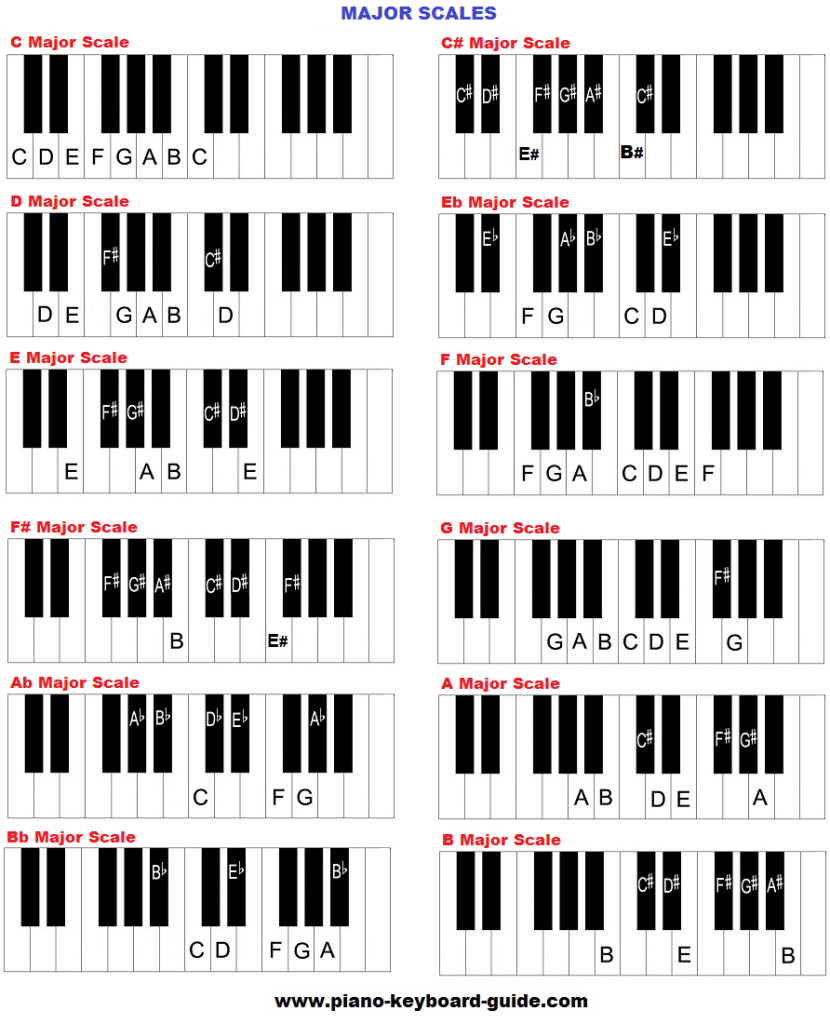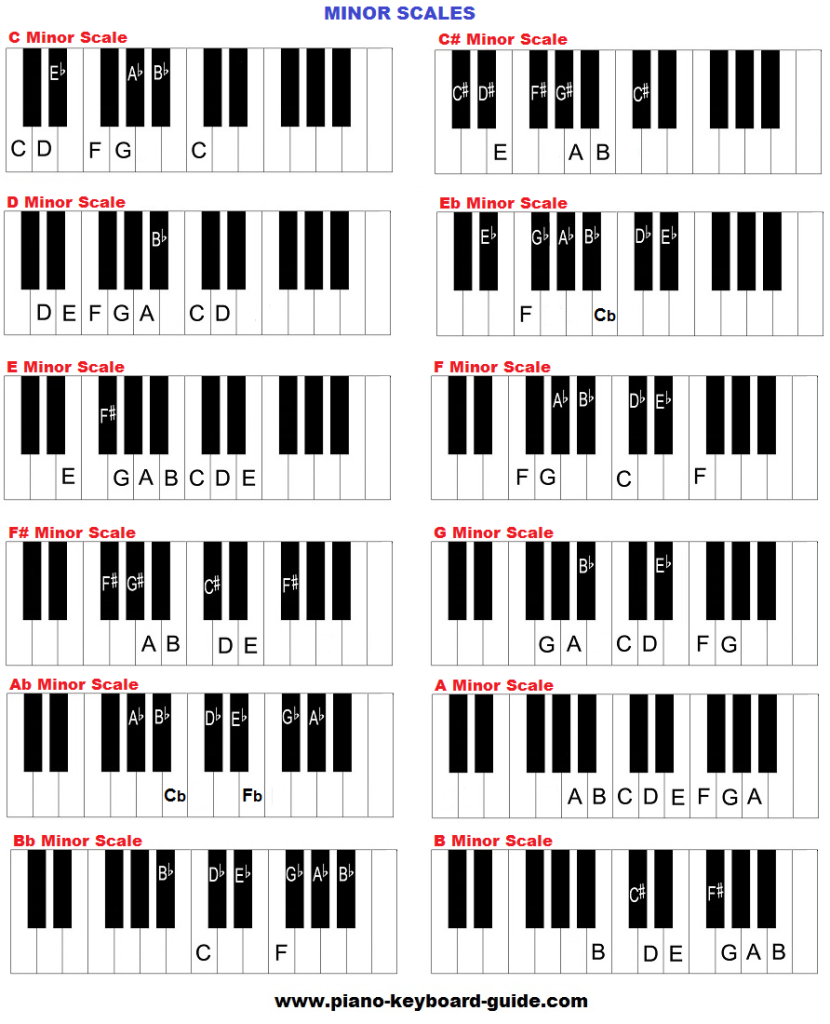Let’s learn major and minor piano music scales in all keys. To understand how to form music scales, you need to understand the concept of whole steps and half steps.
Let’s learn how to form a major scale on piano using a simple formula. The formula is whole – whole – half – whole – whole – whole – half or w-w-h-w-w-w-h. “Whole” stands for a whole step on your piano and “half” stands for a half step.
My #1 Recommendation: Go here to learn about the BEST piano/keyboard course I’ve seen online.
Whole steps and half steps describe the distance from one key or pitch to another.
A whole step always skips a key. For instance, the distance between C and D is a whole step, the distance between B flat and C is a whole step, and so on. The note C sharp (D flat) has been skipped in the first example, and B has been skipped in the second.
A half step never skips a key – you go to the next key. For instance, the distance between C and C sharp (D flat) is a half step, the distance between E and F is a half step, and so on.
There are 8 notes in a scale. You may also remember the scale notes by roman numerals. For instance in the key of C the pitches of scale are C D E F G A B C. In roman numerals it’s I II III IV V VI VII VIII.
So to form major piano music scales, you start with the key name (the root note), then move a whole step, another whole step, a half step, followed by a whole step, whole step, whole step, and finally a half step.
My new book, Piano Scales Made Simple, will help you with your scales. Go here to get it at a discounted price.
Video: How To Form Major Scales On Piano
Take the key of C as an example.
1. The first note is C.
2. A whole step from C takes us to D.
3. Another whole step takes us to E.
4. A half step takes us to F.
5. One whole step higher is G.
6. Another whole step higher is A.
7. Another whole step take us to B.
8. And finally, a half step higher than B is C.
The C major key signature has no sharps and no flats.
Now that we have this sorted out, let’s form piano music scales in the other 11 major keys.
1. The first note is C#.
2. A whole step from C# takes us to D#.
3. Another whole step takes us to E#.
4. A half step takes us to F#.
5. One whole step higher is G#.
6. Another whole step higher is A#.
7. Another whole step take us to B#.
8. And finally, a half step higher than B# is C#.
The C sharp major key signature has 7 sharps.
The D major scale consists of the pitches D, E, F#, G, A, B, and C#. The D major key signature consists of two sharps.
The E flat major scale consists of the pitches Eb, F, G, Ab, Bb, C, and D. Its key signature has three flats: Bb, Eb, Ab.
The E major scale consists of the pitches E, F#, G#, A, B, C#, and D#. Its key signature has four sharps
The F major major scale consists of the pitches F, G, A, Bb, C, D, and E. Its key signature has one flat.
The F-sharp major consists of the pitches F#, G#, A#, B, C#, D#, and E#. Its key signature has six sharps.
The G major scale has the pitches G, A, B, C, D, E, and F#. Its key signature has one sharp, F#.
The A-flat major scale consists of the pitches Ab, Bb, C, Db, Eb, F, and G. Its key signature has four flats.
The A major piano music scale consists of the pitches A, B, C#, D, E, F#, and G#. Its key signature has three sharps, C sharp, F sharp, and G sharp.
The B flat major scale consists of the pitches Bb, C, D, Eb, F, G, and A. Its key signature has two flats, B flat and E flat.
The pitches of the B major scale are B, C#, D#, E, F#, G#, and A#. Its key signature has five sharps.
Major Piano Music Scales Chart:
Natural Minor Scales
Let’s now learn minor piano music scales.
The formula to form a natural minor scale = whole step – half step – whole step – whole step – half step – whole step – whole step or w-h-w-w-h-w-w.
Here are the minor piano music scales in every key:
C minor scale = C – D – Eb – F – G – Ab – Bb – C
D minor scale = D – E – F – G – A – Bb – C – D
E minor scale = E – F# – G – A – B – C – D – E
F minor scale = F – G – Ab – Bb – C – Db – Eb – F
G minor scale = G – A – Bb – C – D – Eb – F – G
A minor scale = A – B – C – D – E – F – G – A
B minor scale = B – C# – D – E – F# – G – A – B
C sharp minor scale = C# – D# – E – F# – G# – A – B – C#
E flat minor scale = Eb – F – Gb – Ab – Bb – Cb – Db – Eb
F sharp minor scale = F# – G# – A – B – C# – D – E – F#
A flat minor scale = Ab – Bb – Cb – Db – Eb – Fb – Gb – Ab
Bb minor scale = Bb – C – Db – Eb – F – Gb – Ab – Bb
Piano Music Scales Video: How To Form Natural Minor Scales
There are three types of minor scales. The one above is the natural or pure minor scale. You can learn how to form other melodic and harmonic minor scales at our main piano music scales section.
Every major key has its relative minor key. The relative minor for a major key falls on the 6th tone of the major scale. For instance the relative minor for C major is A minor. A major key and its relative minor has the same key signature. The notes of a minor scale are the same as its relative major.
Here are the major keys and their relative minor.
Sharps (major – relative minor)
C major – A minor
G major – E minor
D major – B minor
A major – F-sharp minor
E major – C-sharp minor
B major – G-sharp minor
F-sharp major – D-sharp minor
C-sharp major – A-sharp minor
Flats (major – relative minor)
C major – A minor
F major – D minor
B-flat major – G minor
E-flat major – C minor
A-flat major – F minor
D-flat major – B-flat minor
G-flat major – E-flat minor
C-flat major – A-flat minor
For more information on piano scales visit our main piano music scales section.
I highly recommend Piano For All to everyone learning to play the piano. Click here to learn about Piano For All.
Return to Piano Keyboard Home Page.
